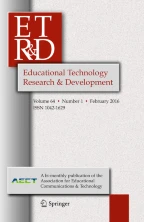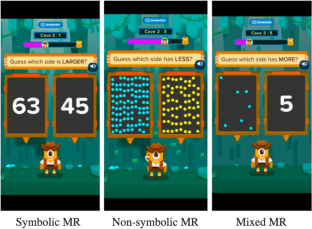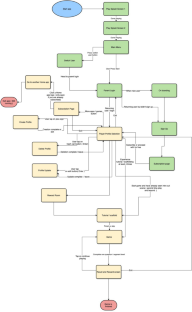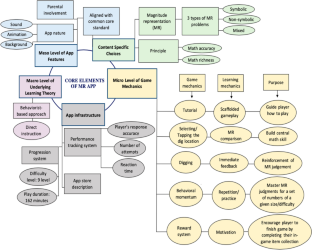Theoretically driven educational app design: the creation of a mathematics app

The present paper documents the design and development of a mobile mathematics application targeted to improve magnitude representation skills. Educational experts worked together with an app developer with the goal of creating an educational app as a math learning tool for children 5–8 years old. The description of the app design processes includes five core elements that we believe are central to the creation of a theory driven educational app. Creating a theory driven educational app is a difficult task; it involves a set of complex decisions as illustrated in this article.
This is a preview of subscription content, log in via an institution to check access.
Access this article
Subscribe and save
Springer+ Basic
€32.70 /Month
- Get 10 units per month
- Download Article/Chapter or eBook
- 1 Unit = 1 Article or 1 Chapter
- Cancel anytime
Buy Now
Price includes VAT (France)
Instant access to the full article PDF.
Rent this article via DeepDyve



Similar content being viewed by others

Comparing types of mathematics apps used in primary school classrooms: an exploratory analysis
Article 26 June 2018

How Might Apps Reshape the Mathematical Learning Experience?
Chapter © 2018

Enhancing Self-Motivation Through Design of an Accessible Math App for Children with Special Needs
Chapter © 2015
Explore related subjects
- Artificial Intelligence
- Digital Education and Educational Technology
References
- Albert, D. (2015). Pushing push—Have notifications come of age? Retrieved from https://www.sitepoint.com/pushing-push-notifications-come-age/
- Ally, M., & Tsinakos, A. (2014). Increasing access through mobile learning. Commonwealth of Learning (COL). BookGoogle Scholar
- Arnab, S., Lim, T., Carvalho, M. B., Bellotti, F., De Freitas, S., Louchart, S., . De Gloria, A. (2015). Mapping learning and game mechanics for serious games analysis. British Journal of Educational Technology, 46(2), 391–411. https://doi.org/10.1111/bjet.12113
- Berch, D. B. (2005). Making sense of number sense: Implications for children with mathematical disabilities. Journal of Learning Disabilities,38(4), 333–339. ArticleGoogle Scholar
- Berkowitz, T., Schaeffer, M. W., Maloney, E. A., Peterson, L., Gregor, C., Levine, S. C., & Beilock, S. L. (2015). Math at home adds up to achievement in school. Science,350(6257), 196–198. https://doi.org/10.1126/science.aac7427ArticleGoogle Scholar
- Blair, K. P. (2013). Learning in critter corral: Evaluating three kinds of feedback in a preschool math app. Proceedings of the 12th international conference on interaction design and children (pp. 372–375). ACM. https://doi.org/10.1145/2485760.2485814ChapterGoogle Scholar
- Booth, J. L., & Siegler, R. S. (2008). Numerical magnitude representations influence arithmetic learning. Child Development,79(4), 1016–1031. https://doi.org/10.1111/j.1467-8624.2008.01173.xArticleGoogle Scholar
- Bray, A., & Tangney, B. (2017). Technology usage in mathematics education research—A systematic review of recent trends. Computers & Education,114, 255–273. https://doi.org/10.1016/j.compedu.2017.07.004ArticleGoogle Scholar
- Bugden, S., & Ansari, D. (2011). Individual differences in children’s mathematical competence are related to the intentional but not automatic processing of Arabic numerals. Cognition,118(1), 32–44. https://doi.org/10.1016/j.cognition.2010.09.005ArticleGoogle Scholar
- Burgstahler, S. (2012). Universal design in education: Process, principles and applications. DO-IT. Google Scholar
- Callaghan, M. N., & Reich, S. M. (2018). Are educational preschool apps designed to teach? An analysis of the app market. Learning, Media and Technology,43(3), 280–293. https://doi.org/10.1080/17439884.2018.1498355ArticleGoogle Scholar
- Case, R., Okamoto, Y., Griffin, S., McKeough, A., Bleiker, C., Henderson, B., . Keating, D. P. (1996). The role of central conceptual structures in the development of children’s thought. Monographs of the Society for Research in Child Development, i-295. https://doi.org/10.2307/1166077
- Cayton-Hodges, G. A., Feng, G., & Pan, X. (2015). Tablet-based math assessment: What can we learn from math apps? Journal of Educational Technology & Society,18(2), 3–20. Google Scholar
- Cezarotto, M. A., & Battaiola, A. L. (2016). Game design recommendations focusing on children with developmental dyscalculia. International conference on learning and collaboration technologies (pp. 463–473). Springer. https://doi.org/10.1007/978-3-319-39483-1_42ChapterGoogle Scholar
- Cheung, A. C., & Slavin, R. E. (2013). The effectiveness of educational technology applications for enhancing mathematics achievement in K-12 classrooms: A meta-analysis. Educational Research Review,9, 88–113. https://doi.org/10.1016/j.edurev.2013.01.001ArticleGoogle Scholar
- Cohen, M., Hadley, M., & Frank, M. (2011). Young children, apps & iPad. US Department of Education Ready to Learn Program,200, 5–10. Google Scholar
- Conole, G., Dyke, M., Oliver, M., & Seale, J. (2004). Mapping pedagogy and tools for effective learning design. Computers & Education, 43(1–2), 17–33. https://doi.org/10.1016/j.compedu.2003.12.018ArticleGoogle Scholar
- Denham, A. R. (2016). Improving the design of a learning game through intrinsic integration and playtesting. Technology, Knowledge and Learning,21(2), 175–194. https://doi.org/10.1007/s10758-016-9280-1ArticleGoogle Scholar
- Dubé, A. K., Alam, S. S., Xu, C., Wen, R., & Kacmaz, G. (2019). Tablets as elementary mathematics education tools: Are they effective and why. Mathematical learning and cognition in early childhood (pp. 223–248). Springer. https://doi.org/10.1007/978-3-030-12895-1_13ChapterGoogle Scholar
- Dubé, A. K., Kacmaz, G., Wen, R., Alam, S. S., & Xu, C. (2020). Identifying quality educational apps: Lessons from ‘top’ mathematics apps in the Apple App Store. Education and Information Technologies,25, 5389–540. https://doi.org/10.1007/s10639-020-10234-zArticleGoogle Scholar
- Dubé, A. K., & Keenan, A. (2016). Are games a viable home numeracy practice? In B. Blevins-Knabe & A. M. B. Austin (Eds.), Early childhood mathematics skill development in the home environment (pp. 165–184). Springer. https://doi.org/10.1007/978-3-319-43974-7_10ChapterGoogle Scholar
- Dubé, A. K., & McEwen, R. N. (2015). Do gestures matter? The implications of using touchscreen devices in mathematics instruction. Learning and Instruction,40(C), 89–98. https://doi.org/10.1016/j.learninstruc.2015.09.002ArticleGoogle Scholar
- Fabian, K., Topping, K. J., & Barron, I. G. (2016). Mobile technology and mathematics: Effects on students’ attitudes, engagement, and achievement. Journal of Computers in Education,3(1), 77–104. https://doi.org/10.1007/s40692-015-0048-8ArticleGoogle Scholar
- Geary, D. C. (2011). Cognitive predictors of achievement growth in mathematics: A 5-year longitudinal study. Developmental Psychology,47(6), 1539. https://doi.org/10.1037/a0025510ArticleGoogle Scholar
- Gebuis, T., & Reynvoet, B. (2011). Generating nonsymbolic number stimuli. Behavior Research Methods,43(4), 981–986. https://doi.org/10.3758/s13428-011-0097-5ArticleGoogle Scholar
- Gersten, R., Jordan, N. C., & Flojo, J. R. (2005). Early identification and interventions for students with mathematics difficulties. Journal of Learning Disabilities,38(4), 293–304. https://doi.org/10.1177/00222194050380040301ArticleGoogle Scholar
- Gilmore, C. K., McCarthy, S. E., & Spelke, E. S. (2010). Non-symbolic arithmetic abilities and mathematics achievement in the first year of formal schooling. Cognition,115(3), 394–406. https://doi.org/10.1016/j.cognition.2010.02.002ArticleGoogle Scholar
- Gray, P. (2013). Free to learn: Why unleashing the instinct to play will make our children happier, more self-reliant, and better students for life. Basic Books. Google Scholar
- Gröger, C., Silcher, S., Westkämper, E., & Mitschang, B. (2013). Leveraging apps in manufacturing. A framework for app technology in the enterprise. Procedia CIRP,7, 664–669. https://doi.org/10.1016/j.procir.2013.06.050ArticleGoogle Scholar
- Halberda, J., & Feigenson, L. (2008). Developmental change in the acuity of the “number sense”: The Approximate Number System in 3-, 4-, 5-, and 6-year-olds and adults. Developmental Psychology,44(5), 1457. https://doi.org/10.1037/a0012682ArticleGoogle Scholar
- Harari, G. M., Müller, S. R., Stachl, C., Wang, R., Wang, W., Bühner, M., Rentfrow, P. J., Campbell, A. T., & Gosling, S. D. (2019). Sensing sociability: Individual differences in young adults’ conversation, calling, texting, and app use behaviors in daily life. Journal of Personality and Social Psychology. https://doi.org/10.1037/pspp0000245ArticleGoogle Scholar
- Hawes, Z., Nosworthy, N., Archibald, L., & Ansari, D. (2019). Kindergarten children’s symbolic number comparison skills predict 1st grade mathematics achievement: Evidence from a two-minute paper-and-pencil test. Learning and Instruction,59, 21–33. ArticleGoogle Scholar
- Highfield, K., & Goodwin, K. (2013). Apps for mathematics learning: A review of ‘educational’ apps from the iTunes App Store. In V. Steinle, L. Ball, & C. Bardini (Eds.), Mathematics education: Yesterday, today and tomorrow. Proceedings of the 36th annual conference of the Mathematics Education Research Group of Australasia (pp. 378–385). MERGA. Google Scholar
- Hill, H. C., Blunk, M. L., Charalambous, C. Y., Lewis, J. M., Phelps, G. C., Sleep, L., & Ball, D. L. (2008). Mathematical knowledge for teaching and the mathematical quality of instruction: An exploratory study. Cognition and Instruction,26(4), 430–511. https://doi.org/10.1080/07370000802177235ArticleGoogle Scholar
- Hirsh-Pasek, K., Zosh, J. M., Golinkoff, R. M., Gray, J. H., Robb, M. B., & Kaufman, J. (2015). Putting education in “educational” apps: Lessons from the science of learning. Psychological Science in the Public Interest,16(1), 3–34. https://doi.org/10.1177/1529100615569721ArticleGoogle Scholar
- Hourcade, J. P. (2008). Interaction design and children. Foundations and Trends® in Human—Computer Interaction,1(4), 277–392. https://doi.org/10.1177/00222194050380040901ArticleGoogle Scholar
- Joyce, B., Weil, M., & Showers, B. (1992). Models of teaching (4th ed.). Boston: Allyn & Bacon. Google Scholar
- Kafai, Y. B. (2016). From computational thinking to computational participation in K–12 education. Communications of the ACM,59(8), 26–27. https://doi.org/10.1145/2955114ArticleGoogle Scholar
- Kalchman, M., Moss, J., & Case, R. (2001). Psychological models for the development of mathematical understanding: Rational numbers and functions. In S. M. Carver & D. Klahr (Eds.), Cognition and instruction: Twenty-five years of progress (pp. 1–38). Erlbaum. Google Scholar
- Kato, P. M., Cole, S. W., Bradlyn, A. S., & Pollock, B. H. (2008). A video game improves behavioral outcomes in adolescents and young adults with cancer: A randomized trial. Pediatrics,122(2), e305–e317. https://doi.org/10.1542/peds.2007-3134ArticleGoogle Scholar
- Kaufmann, L., Koppelstaetter, F., Siedentopf, C., Haala, I., Haberlandt, E., Zimmerhackl, L. B., . Ischebeck, A. (2006). Neural correlates of the number–size interference task in children. Neuroreport, 17(6), 587
- Ke, F. (2016). Designing and integrating purposeful learning in game play: A systematic review. Educational Technology Research and Development,64(2), 219–244. https://doi.org/10.1007/s11423-015-9418-1ArticleGoogle Scholar
- Kebritchi, M., & Hirumi, A. (2008). Examining the pedagogical foundations of modern educational computer games. Computers & Education,51(4), 1729–1743. https://doi.org/10.1016/j.compedu.2008.05.004ArticleGoogle Scholar
- Kloos, H., & Van Orden, G. C. (2005). Can a preschooler’s mistaken belief benefit learning? Swiss Journal of Psychology, 64(3), 195–205. https://doi.org/10.1024/1421-0185.64.3.195ArticleGoogle Scholar
- Ku, O., Chen, S. Y., Wu, D. H., Lao, A. C., & Chan, T. W. (2014). The effects of game-based learning on mathematical confidence and performance: High ability vs. low ability. Journal of Educational Technology & Society,17(3), 65–78. Google Scholar
- Larkin, K. (2015). “An app! an app! my kingdom for an app”: An 18-month quest to determine whether apps support mathematical knowledge building. Digital games and mathematics learning (pp. 251–276). Springer. https://doi.org/10.1007/978-94-017-9517-3_13ChapterGoogle Scholar
- Laurillard, D. (2016). Learning number sense through digital games with intrinsic feedback. Australasian Journal of Educational Technology. https://doi.org/10.14742/ajet.3116ArticleGoogle Scholar
- Libertus, M. E., Feigenson, L., & Halberda, J. (2011). Preschool acuity of the approximate number system correlates with school math ability. Developmental Science,14(6), 1292–1300. https://doi.org/10.1111/j.1467-7687.2011.01080.xArticleGoogle Scholar
- Martens, M., Rinnert, G. C., & Andersen, C. (2018). Child-centered design: Developing an inclusive letter writing app. Frontiers in Psychology,6(9), 2277. https://doi.org/10.3389/fpsyg.2018.02277ArticleGoogle Scholar
- Matejko, A. A., & Ansari, D. (2016). Trajectories of symbolic and non-symbolic magnitude processing in the first year of formal schooling. PLoS ONE,11(3), e0149863. https://doi.org/10.1371/journal.pone.0149863ArticleGoogle Scholar
- Mayer, R. E. (2014). Computer games for learning: An evidence-based approach. The MIT Press. BookGoogle Scholar
- McEwen, R. N., & Dubé, A. K. (2015). Engaging or distracting: Children’s tablet computer use in education. Journal of Educational Technology & Society,18(4), 9–23. Google Scholar
- McEwen, R., & Dubé, A. K. (2016). Intuitive or Idiomatic? An information studies and cognitive psychology study of child-tablet computer interaction. Journal of the Association for Information Science and Technology,67, 1169–1181. ArticleGoogle Scholar
- McEwen, R., & Dubé, A. K. (2017). Understanding tablets from early childhood to adulthood: Encounters with touch technology. Routledge. https://doi.org/10.4324/9781315389486BookGoogle Scholar
- Melhuish, K., & Falloon, G. (2010). Looking to the future: M-learning with the iPad. Computers in New Zealand Schools: Learning, Leading, Technology,22, 1–16. Google Scholar
- Mera, C., Ruiz, G., Aguilar, M., Aragón, E., Delgado, C., Menacho, I., . Navarro, J. I. (2019). Coming together: R&D and children’s entertainment company in designing apps for learning early Math. Frontiers in Psychology, 9, 2751. https://doi.org/10.3389/fpsyg.2018.02751
- Merkley, R., & Ansari, D. (2010). Using eye tracking to study numerical cognition: The case of the ratio effect. Experimental Brain Research,206(4), 455–460. https://doi.org/10.1007/s00221-010-2419-8ArticleGoogle Scholar
- Moss, J., Bruce, C. D., & Bobis, J. (2016). Young children’s access to powerful mathematical ideas: A review of current challenges and new developments in the early years. In L. English & D. Kirshner (Eds.), Handbook of international research in mathematics education (3rd ed., pp. 153–190). Routledge. Google Scholar
- Moyer-Packenham, S., Salkind, G., & Bolyard, J. J. (2008). Virtual manipulatives used by K-8 teachers for mathematics instruction: The influence of mathematical, cognitive, and pedagogical fidelity. Contemporary Issues in Technology and Teacher Education,8(3), 202–218. Google Scholar
- Mozelius, P., Fagerström, A., & Söderquist, M. (2017). Motivating factors and tangential learning for knowledge acquisition in educational games. Electronic Journal of e-Learning,15(4), 343–354. Google Scholar
- Mussolin, C., Noël, M. P., Pesenti, M., Grandin, C., & De Volder, A. (2013). Neural correlates of the numerical distance effect in children. Frontiers in Psychology,4, 663. https://doi.org/10.3389/fpsyg.2013.00663ArticleGoogle Scholar
- Naismith, L., Lonsdale, P., Vavoula, G., & Sharples, M. (2004). ‘Mobile technologies and learning’ infuturelabliterature review series. Report No. 11, Futurelab. NESTA (National Endowment for Science Technology and the Arts), Bristol, UK.
- Odic, D., Hock, H., & Halberda, J. (2014). Hysteresis affects approximate number discrimination in young children. Journal of Experimental Psychology,143(1), 255. https://doi.org/10.1037/a0030825ArticleGoogle Scholar
- Paas, F., Renkl, A., & Sweller, J. (2004). Cognitive load theory: Instructional implications of the interaction between information structures and cognitive architecture. Instructional Science,32(1), 1–8. ArticleGoogle Scholar
- Patino, A., Romero, M., & Proulx, J. N. (2016). Analysis of game and learning mechanics according to the learning theories. 2016 8th International conference on games and virtual worlds for serious applications (VS-GAMES) (pp. 1–4). IEEE. https://doi.org/10.1109/VS-GAMES.2016.7590337ChapterGoogle Scholar
- Pham, X. L., & Chen, G. D. (2019). PACARD: A New interface to increase mobile learning app engagement, distributed through App Stores. Journal of Educational Computing Research,57(3), 618–645. https://doi.org/10.1177/0735633118756298ArticleGoogle Scholar
- Piazza, M., Facoetti, A., Trussardi, A. N., Berteletti, I., Conte, S., Lucangeli, D., . Zorzi, M. (2010). Developmental trajectory of number acuity reveals a severe impairment in developmental dyscalculia. Cognition, 116(1), 33-41. https://doi.org/10.1016/j.cognition.2010.03.012
- Pilli, O., & Aksu, M. (2013). The effects of computer-assisted instruction on the achievement, attitudes and retention of fourth grade mathematics students in North Cyprus. Computers & Education,62, 62–71. https://doi.org/10.1016/j.compedu.2012.10.010ArticleGoogle Scholar
- Plass, J. L., Frye, J., Kinzer, C., Homer, B., & Perlin, K. (2011). Learning mechanics and assessment mechanics for games for learning (G4LI White Paper 01–2011). Games for Learning Institute. https://doi.org/10.13140/2.1.3127.1201BookGoogle Scholar
- Plowman, L., Stevenson, O., Stephen, C., & McPake, J. (2012). Preschool children’s learning with technology at home. Computers & Education,59(1), 30–37. https://doi.org/10.1016/j.compedu.2011.11.014ArticleGoogle Scholar
- Porter, J. (2018). Entering Aladdin’s cave: Developing an app for children with Down syndrome. Journal of Computer Assisted Learning,34(4), 429–439. https://doi.org/10.1111/jcal.12246ArticleGoogle Scholar
- Proulx, J.-N., Romero, M., & Arnab, S. (2016). Learning mechanics and game mechanics under the perspective of self-determination theory to foster motivation in digital game-based learning. Simulation & Gaming,48(1), 81–97. https://doi.org/10.1177/1046878116674399ArticleGoogle Scholar
- Salen, K., Tekinbaş, K. S., & Zimmerman, E. (2004). Rules of play: Game design fundamentals. MIT press. Google Scholar
- Sarnecka, B. W., & Carey, S. (2008). How counting represents number: What children must learn and when they learn it. Cognition,108(3), 662–674. https://doi.org/10.1016/j.cognition.2008.05.007ArticleGoogle Scholar
- Schaefer, C., & Millman, H. L. (1994). How to help children with common problems. Jason Aronson Inc. Google Scholar
- Senge, P. M. (2006). The fifth discipline: The art and practice of the learning organization. Broadway Business. Google Scholar
- Shuler, C., Levine, Z., & Ree, J. (2012). iLearn II An analysis of the education category of Apple’s app store. The Joan Ganz Cooney Center. Google Scholar
- Sicart, M. (2008). Defining game mechanics. Game Studies,8(2), 1–14. Google Scholar
- Siegler, R. S. (2016). Magnitude knowledge: The common core of numerical development. Developmental Science,19(3), 341–361. https://doi.org/10.1111/desc.12395ArticleGoogle Scholar
- Siegler, R. S., & Lortie-Forgues, H. (2014). An integrative theory of numerical development. Child Development Perspectives,8(3), 144–150. https://doi.org/10.1111/cdep.12077ArticleGoogle Scholar
- Skinner, B. F. (1968). The technology of teaching. Appleton-Century-Crofts. Google Scholar
- Slavin, R. E., & Lake, C. (2008). Effective programs in elementary mathematics: A best-evidence synthesis. Review of Educational Research,78(3), 427–515. https://doi.org/10.3102/0034654308317473ArticleGoogle Scholar
- Statista Research Development. (July 14, 2021). Most popular Apple App Store categories in June 2021, by share of available app. Retrieved from https://www.statista.com/statistics/270291/popular-categories-in-the-app-store/
- Tsay, C.H.-H., Kofinas, A., & Luo, J. (2018). Enhancing student learning experience with technology-mediated gamification: An empirical study. Computers & Education,121, 1–17. https://doi.org/10.1016/j.compedu.2018.01.009ArticleGoogle Scholar
- Tucker, S. I., Moyer-Packenham, P. S., Shumway, J. F., & Jordan, K. E. (2016). Zooming in on children’s thinking: How a number line app revealed, concealed, and developed children’s number understanding. Australian Primary Mathematics Classroom,21(1), 23. Google Scholar
- Vatavu, R. D., Cramariuc, G., & Schipor, D. M. (2015). Touch interaction for children aged 3 to 6 years: Experimental findings and relationship to motor skills. International Journal of Human—Computer Studies,74, 54–76. https://doi.org/10.1016/j.ijhcs.2014.10.007ArticleGoogle Scholar
- Warwick, J. (2008). Mathematical self-efficacy and student engagement in the mathematics classroom. MSOR Connections,8(3), 31–37. https://doi.org/10.11120/msor.2008.08030031ArticleGoogle Scholar
- Willoughby, D., Evans, M. A., & Nowak, S. (2015). Do ABC eBooks boost engagement and learning in preschoolers? An experimental study comparing eBooks with paper ABC and storybook controls. Computers & Education,82, 107–117. https://doi.org/10.1016/j.compedu.2014.11.008ArticleGoogle Scholar
- Wilson, A. J., & Dehaene, S. (2007). Number sense and developmental dyscalculia. Human behavior, learning, and the developing brain: Atypical Development (Vol. 2, pp. 212–237). Guilford Press. Google Scholar
- Wilson, A. J., Dehaene, S., Pinel, P., Revkin, S. K., Cohen, L., & Cohen, D. (2006). Principles underlying the design of “The Number Race”, an adaptive computer game for remediation of dyscalculia. Behavioural and Brain Functions,2, 1–14. ArticleGoogle Scholar
- Wynn, K. (1992). Children’s acquisition of the number words and the counting system. Cognitive Psychology,24(2), 220–251. https://doi.org/10.1016/0010-0285(92)90008-PArticleGoogle Scholar
- Zichermann, G., & Cunningham, C. (2011). Gamification by design: Implementing game mechanics in web and mobile apps. O’Reilly Media Inc. Google Scholar
Funding
This study was funded by Social Sciences and Humanities Research Council of Canada (Grant No. 430-2017-00230).
Author information
Authors and Affiliations
- Department of Educational and Counselling Psychology, McGill University, 3700 McTavish Street, Montreal, QC, H3A 1Y2, Canada Sabrina Shajeen Alam & Adam Kenneth Dubé
- Sabrina Shajeen Alam
You can also search for this author in PubMed Google Scholar
You can also search for this author in PubMed Google Scholar
Contributions
Author A is listed as a developer in the credits of the application but is not an employee of the company or member of its board.
Corresponding author
Ethics declarations
Conflict of interest
The authors have no competing interest to declare that are relevant to the content of this article. The authors collaborated with a company to develop the app so that it can be used for research. The app was then further developed by the company for commercial purposes.
Informed consent
Research involving human and/or animal participants
No ethical approval was required as there were no human participants and/or animals involved.
Additional information
Publisher's Note
Springer Nature remains neutral with regard to jurisdictional claims in published maps and institutional affiliations.





